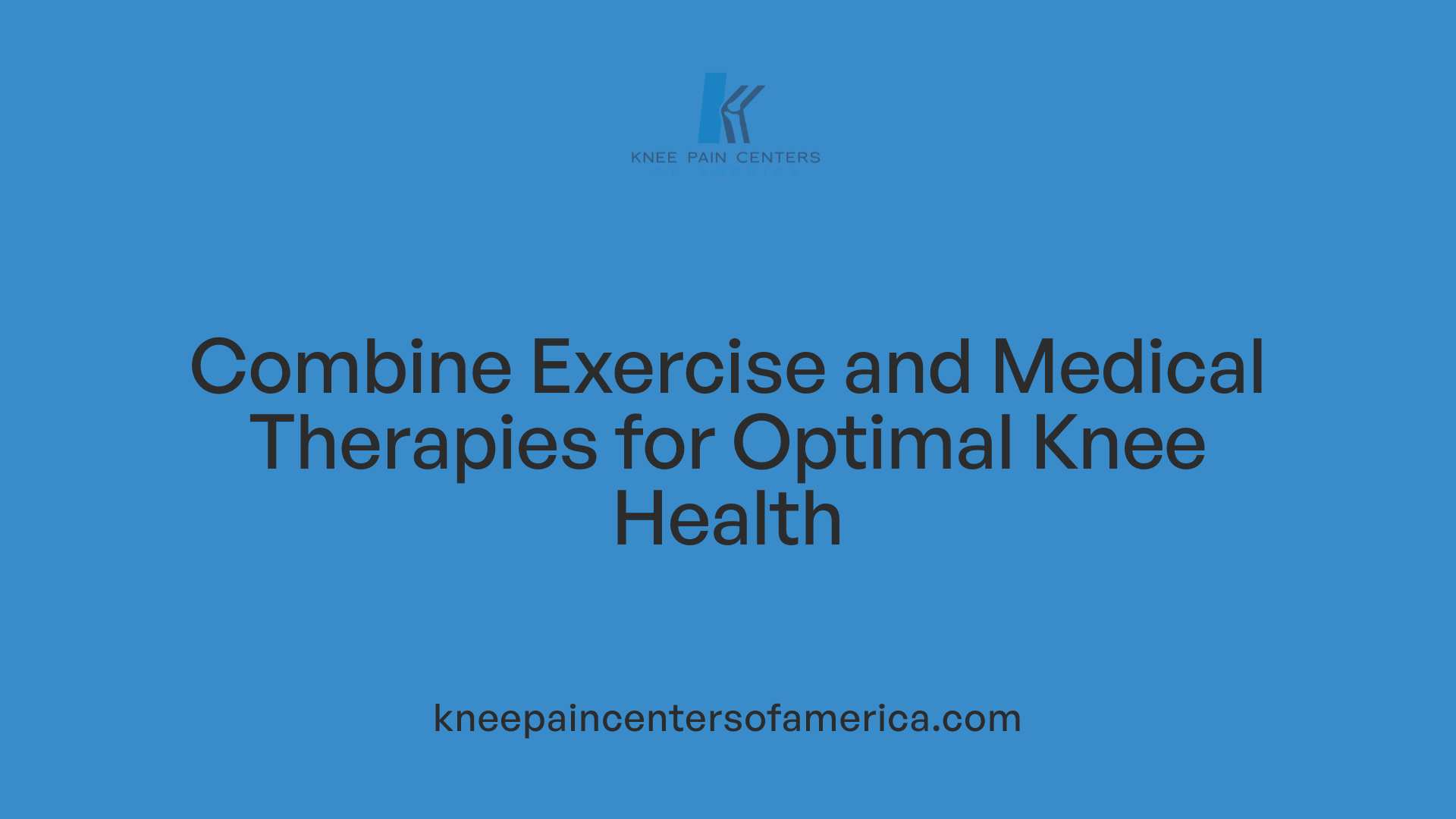Understanding the Role of Exercise in Knee Health
Knee pain and osteoarthritis are prevalent conditions that can significantly impact daily function and quality of life. While medical treatments range from medication to surgery, non-surgical therapies, notably targeted exercise programs, are fundamental in managing symptoms and improving joint stability. Among these, resistance band exercises have gained attention for their effectiveness in strengthening the muscles around the knee, supporting joint health, and enhancing mobility safely.
The Importance of Resistance Band Exercises for Knee Stability and Pain Management

Role of Quadriceps, Hamstrings, Glutes, and Lower Back Muscles in Knee Support
The knee joint’s stability and function heavily rely on the strength of muscles surrounding it. The quadriceps help in knee extension and provide front support, while the hamstrings contribute to knee flexion and protect the joint at the back. Glute muscles stabilize the pelvis and improve leg alignment, reducing undue stress on the knee. Lower back muscles play a supportive role by maintaining overall posture, which indirectly influences knee mechanics. Strengthening these groups collectively enhances joint stability and reduces strain, which is essential for people managing knee osteoarthritis.
Examples of Resistance Band Exercises Beneficial for Knee Health
Resistance bands are effective tools to target the knee-supporting muscles. Some beneficial exercises include:
- Side-Steps with Resistance Band: Keeps hip and thigh muscles engaged, improving lateral knee stability.
- Leg Press with Resistance Band: Targets quadriceps and glutes, building joint support.
- Seated Knee Lifts: Strengthens hip flexors and surrounding muscles without putting excessive load on the joint.
- Bridge with Leg Extension: Activates glutes and hamstrings, promoting better support around the knee.
Other helpful exercises include speed skaters and leg lifts, all designed to gradually strengthen muscles while respecting joint comfort.
Mechanics and Safety Considerations When Using Resistance Bands
When using resistance bands, proper form and gradual progression are crucial. Exercises should be performed with slow, controlled movements, typically at 60-70% of one’s one-repetition maximum effort, to maximize muscle strengthening without causing injury.
Safety tips include:
- Begin with gentle stretching before exercising to prepare muscles and joints.
- Avoid any pain beyond a mild level; pain between 0-5 on a pain scale may be acceptable but above that should prompt modification or stopping.
- Use the correct resistance band strength suited to your ability—too tight can cause strain, too loose will not be effective.
- Ensure proper footwear and foot placement to maintain balance and avoid secondary joint stress.
By incorporating these resistance band exercises with attention to safety and gradual intensity, individuals with knee pain or osteoarthritis can improve their knee stability and reduce discomfort effectively.
What Non-Surgical Therapies Are Available to Manage Osteoarthritis of the Knee?
Non-surgical management includes physical therapy focusing on muscle strengthening and stability around the knee, which complements resistance band exercises. Weight management and low-impact aerobic activities like swimming or cycling help reduce joint pressure. Supportive devices such as knee braces provide mechanical support to ease pain.
Medications like NSAIDs can provide temporary relief, while corticosteroid or hyaluronic acid injections may relieve symptoms short term. Emerging treatments such as genicular artery embolization (GAE) offer new options by reducing inflammation through controlled blood flow. Complementary therapies like acupuncture, massage, and topical applications also assist in reducing pain and improving quality of life.
Together, these approaches delay surgical intervention and enhance everyday function and comfort for individuals with knee osteoarthritis.
Guidelines and Techniques for Safe and Effective Knee Band Exercises

Proper warm-up routines such as cycling or walking
Before engaging in knee strengthening exercises, it is essential to prepare the joints and muscles through a warm-up. Activities like stationary cycling or walking are recommended as they increase blood flow to the knee joint and surrounding tissues. This preparation helps reduce the risk of injury and enhances performance during the exercise session.
Recommended frequency, sets, and repetitions for strengthening exercises
To effectively build strength and support around the knee, exercises such as leg presses with resistance bands, step-ups, or side lunges should be performed with controlled repetitions and sets. Typically, doing 1 to 4 sets of 12-15 repetitions two to three times weekly helps improve knee stability and function. Gradual progression, starting with lower repetitions and increasing over time, facilitates steady improvements without overstraining the joint.
Pain monitoring and modifications during exercise
Monitoring pain is critical during knee exercises. An acceptable pain level is rated between 0 to 5 on a subjective scale; exceeding this suggests the need to adjust or stop the activity. Exercises should not cause worsening knee pain overall, though brief muscle soreness is normal if it subsides quickly. It is advised to stop exercises immediately if symptoms worsen and seek professional guidance if pain persists beyond six weeks.
Benefits of slow, controlled strength training at specific intensity levels
Strength training for the knee should be performed with slow, controlled movements at about 60-70% of the individual’s one-rep max. This intensity range maximizes muscle strengthening while minimizing joint stress. Such training targets key muscle groups like the quadriceps, hamstrings, and glutes that surround and stabilize the knee. Controlled exercise slows arthritis progression, improves knee mobility, and enhances daily function.
These exercise strategies align with recommendations provided by physical therapy experts and health organizations, emphasizing safety and gradual conditioning for those managing knee pain or osteoarthritis.
Effective Knee Band Exercise Variations to Target Key Muscle Groups

Which exercises effectively strengthen muscles around the knee using resistance bands?
Resistance band exercises are excellent for enhancing knee stability and mobility. Effective variations include side-steps with resistance bands, leg presses with resistance bands, and seated knee lifts. These exercises specifically target muscles essential for knee support, such as the quadriceps, hamstrings, glutes, calves, and lower back.
How do these exercises support knee function?
Each exercise variation emphasizes controlled movements to strengthen muscle groups that stabilize the knee joint. For example, side-steps activate hip abductors and glutes, providing lateral knee support. Leg presses engage the quadriceps and hamstrings to enhance knee extension and flexion strength, while speed skaters mimic lateral agility movements, promoting dynamic stability. Sit-to-stand and bridging exercises further bolster overall leg strength and responsiveness.
What adaptations accommodate varying ability levels and knee conditions?
Exercise modifications ensure safety and effectiveness for different users. Resistance band tension can be adjusted from light to moderate to suit comfort and strength. For beginners or those with osteoarthritis, starting with fewer reps (e.g., 1–2 sets of 12–15 reps) and lower resistance prevents overexertion. Physical therapy guidance helps tailor progression while emphasizing pain tolerance—exercise should never cause pain beyond mild discomfort. Incorporating gentle stretching and warm-ups like stationary cycling prepares the knee for activity.
This tailored approach supports gradual muscle strengthening, improves joint function, and can slow arthritis progression. Always monitor symptoms and consult healthcare professionals if pain worsens or persists beyond several weeks.
Integrating Knee Band Exercises with Medical and Regenerative Treatments

How do corticosteroid injections help in treating knee osteoarthritis?
Corticosteroid injections are commonly used to reduce inflammation within the knee joint, helping to alleviate pain and improve mobility temporarily. These injections deliver anti-inflammatory medication directly into the joint, often with imaging guidance to ensure precise placement. While the relief they provide can last from weeks to a few months, repeated injections are limited to prevent joint damage—generally no more than three to four per year are recommended. Importantly, corticosteroids address symptoms but do not stop arthritis progression.
What advancements have been made in regenerative medicine for knee osteoarthritis treatment?
Regenerative medicine has introduced promising therapies such as platelet-rich plasma (PRP) and mesenchymal stem cell (MSC) injections. PRP offers anti-inflammatory benefits and is most effective in early osteoarthritis stages, whereas MSC treatments aid tissue repair and increase cartilage volume in moderate disease. Techniques like the RECLAIM procedure, which uses the patient's own cells for cartilage regeneration, are under clinical trials and show potential for restoring joint function. Additionally, research into exosomes, placental extracts, and gene therapy aims to further enhance cartilage repair.
How does resistance training complement corticosteroid and hyaluronic acid injections?
Exercise programs targeting knee muscles—such as quadriceps stretches, leg lifts, step-ups, and resistance band exercises—strengthen muscles supporting the knee joint, including quadriceps, hamstrings, and glutes. This muscular support stabilizes the joint, potentially slowing arthritis progression and reducing reliance on injections. Strengthening exercises should be performed with controlled movements at moderate intensity, ideally 2-3 times weekly in sets of 12-15 repetitions, combined with warm-ups like stationary cycling to prepare the joint.
What role does exercise play in enhancing surgical outcomes and slowing arthritis progression?
Physical therapy-guided exercise improves knee strength, stability, and daily function, which can enhance recovery after surgeries like joint replacement. Furthermore, building muscle around the knee helps protect and support the joint, potentially preventing or slowing the progression of osteoarthritis. Exercises focusing on movement, strength, and tissue healing—such as bridging, sit-to-stand, side lunges, and static quad strengthening—are recommended. These should be done gradually with attention to pain levels, stopping if pain worsens.
Integrating prescribed knee exercises alongside medical injections and innovative regenerative therapies creates a comprehensive approach to managing knee osteoarthritis. This strategy supports joint health by combining symptom relief, tissue repair, and improved muscular support for better function and quality of life.
When to Consider Surgical Options and the Role of Exercise Before and After Surgery

When is knee replacement surgery recommended for osteoarthritis patients?
Knee replacement surgery is usually recommended when traditional treatments like exercise therapy, medication, and weight management no longer relieve severe pain or mobility problems. This surgery is typically considered if symptoms have lasted for months, greatly reduce quality of life, and imaging shows osteoarthritis progression. Generally, candidates are over 60, but age alone is not a restriction—it depends on overall health and activity demands.
Why strengthen muscles before and after surgery?
Strengthening exercises before surgery help improve the muscles around the knee—such as the quadriceps, hamstrings, and glutes—which can support better joint stability and function. This preparation can lead to a smoother surgery and faster recovery. After surgery, carefully guided strengthening aids tissue healing, restores joint mobility, and improves functional independence.
How should symptoms be monitored?
Patients should closely monitor pain and swelling. New or worsening symptoms require prompt communication with healthcare providers. Exercise pain levels should ideally stay between 0 to 5 on a pain scale; higher pain signals should prompt modification or cessation of exercises. If symptoms do not improve within six weeks or get worse, further medical evaluation is important.
What are guidelines for safe exercise progression and recovery?
Gradual progression is essential. Start exercises slowly, focusing on gentle stretching and strengthening, and increase repetitions and resistance carefully. Warm-ups like stationary cycling boost blood flow and prepare the knee. Post-surgery, physical therapy-led programs are recommended for tailored recovery. Safety tips include avoiding exercises that cause significant pain and using resistance bands correctly.
| Topic |
Description |
Importance |
| Surgery Indications |
Persistent pain, impaired mobility, failed conservative treatment, imaging confirming osteoarthritis |
Ensures surgery is justified and timely |
| Pre-surgery Exercise |
Muscle strengthening around knee improves surgery outcomes |
Enhances recovery and joint stability |
| Post-surgery Exercise |
Controlled strengthening and mobility exercises aid healing and functional restoration |
Helps regain independence and prevent complications |
| Symptom Monitoring |
Pain scale monitoring (0-5), addressing worsening symptoms promptly |
Prevents injury and ensures safe exercise practice |
| Gradual Progression Guidelines |
Start slow, warm-up, increase sets/reps cautiously, use correct technique |
Maximizes benefits while minimizing risks |
Maximizing Knee Health Through Exercise and Medical Collaboration
Resistance band exercises serve as a vital component of a multidisciplinary approach to managing knee pain and osteoarthritis. By strengthening surrounding muscles, enhancing joint stability, and improving mobility with controlled, safe techniques, these exercises complement medical therapies ranging from corticosteroid injections to emerging regenerative treatments. For patients considering surgical options, pre- and post-operative exercise supports better outcomes and recovery. Ultimately, personalized exercise regimens integrated with medical guidance offer the best pathway to sustained knee health, improved function, and quality of life.
References